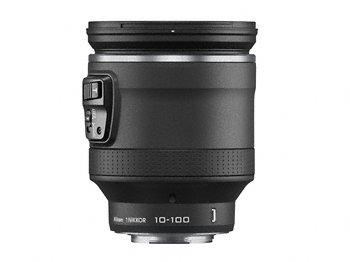Hamish Gill
Tech Support (and Marketing)
Nikon have announced a their new mirrorless interchangeable system with the catchy name of Nikon 1.
The name is seemingly derived from the 1" type sensor it uses.
A 1" sensor roughly translates to a 2.7x crop factor.
This means a 10mm lens will give an equivelent focal length of 27mm and a "normal lens" ie approx 50mm would require a 18mm lens on a Nikon 1 system camera.
With me so far? No?
Basically, its a smaller sensor than in the Panasonic G series cameras (2x crop factor) But bigger than most no interchangeable lens cameras such as the Nikon 7100 (4.5x crop factor)
I'm telling you all this to help explain where this camera will fit in to the market place, or seemingly more importantly Nikon's market.
This new format is being touted as "CX" by Nikon, they already have "DX" cameras and "FX" cameras
CX is for these small interchangeable lens cameras
DX is for (currently) consumer level DSLRs
FX is for Pro DSLRs
It would appear that Nikon have done this so as not to affect sales of their already very popular consumer level DSLR's
The smaller sensor of this range of cameras should give Nikon the ability to create an interchangeable lens system camera that is actually much closer to the size of non interchangeable lens compact cameras. And that appears to be what they have done...
By doing this they are seemingly pitching this camera at a market place currently only filled with the Pentax Q.
Whether or not this is a good idea or not will remain to be seen... my guess is that the Nikon brand will work well in its favor.
Image quality will of course be a factor, and there is no telling how well they will fair until they are in the hands of the users ... But in good time im sure they will be plenty of pixel peepers to tell us all about it all over the internet!
So what about the cameras them selves?
There are 2!
First is the J1, the smaller of the two ...

also available in red pink and silver
with the following specs
10mega pixels
Hybrid AF
10fps shooting with AF
60fps without AF
High def video
lots more here
Then there is the V1

Seemingly the same specs but with a EFV, magnesium alloy body and ability to attach a flash
lots more here
So where do they stand out from the crowd?
Well, speed is obviously a factor here!
60fps is a lot of shots in a second!
How useful this is day to day, I'm not sure?
2 features that seem to have come from this are as follows
Perhaps not aimed at the traditional photographer, but with the constant bluring of lines between video and still hardware this is an inevitable upshot(?)
The second thing that makes this camera stand out from the crowd is the Hybrid AF
Although Nikons info regarding this is somewhere less than useful as to how this will be an advantage...
As for lenses
There is a 10-30mm (27-81 equiv)
http://www.europe-nikon.com/tmp/EU/2419865273/3760176746/2327365364/27184057/1391280926/2780083465/1237327324/1809293855/4144066801/3706136198/859545615.jpg[/img}
[URL]http://www.europe-nikon.com/en_GB/product/1-nikkor-lenses/1-nikkor-vr-10-30mm-f-3-5-5-6[/URL]
a 30-110 (81-297mm equiv)
[IMG]http://www.europe-nikon.com/tmp/EU/2419865273/3760176746/2327365364/27184057/1391280926/2780083465/1237327324/1926009694/4144066801/3706136198/1050939436.jpg
http://www.europe-nikon.com/en_GB/product/1-nikkor-lenses/1-nikkor-vr-30-110mm-f-3-8-5-6
a 10mm f2.8 pancake

http://www.europe-nikon.com/en_GB/product/1-nikkor-lenses/1-nikkor-10mm-f-2-8
And a 10-100mm (27-270 equiv)

http://www.europe-nikon.com/en_GB/product/1-nikkor-lenses/1-nikkor-vr-10-100mm-f-4-5-5-6-pd-zoom
There is also an AFS compatible adapter that allows the user to attach current nikon f mount lenses

http://www.europe-nikon.com/en_GB/product/accessories/1-nikkor-lenses/others/f-mount-adapter
which would (should i chose to buy all this kit) mean i could attach my 70-200mm 2.8 lens to one of these and have 10mp of 540mm f2.8 60fps to play with ... ... ... which might be fun
lots more to look at on Nikon's site here
The name is seemingly derived from the 1" type sensor it uses.
A 1" sensor roughly translates to a 2.7x crop factor.
This means a 10mm lens will give an equivelent focal length of 27mm and a "normal lens" ie approx 50mm would require a 18mm lens on a Nikon 1 system camera.
With me so far? No?
Basically, its a smaller sensor than in the Panasonic G series cameras (2x crop factor) But bigger than most no interchangeable lens cameras such as the Nikon 7100 (4.5x crop factor)
I'm telling you all this to help explain where this camera will fit in to the market place, or seemingly more importantly Nikon's market.
This new format is being touted as "CX" by Nikon, they already have "DX" cameras and "FX" cameras
CX is for these small interchangeable lens cameras
DX is for (currently) consumer level DSLRs
FX is for Pro DSLRs
It would appear that Nikon have done this so as not to affect sales of their already very popular consumer level DSLR's
The smaller sensor of this range of cameras should give Nikon the ability to create an interchangeable lens system camera that is actually much closer to the size of non interchangeable lens compact cameras. And that appears to be what they have done...
By doing this they are seemingly pitching this camera at a market place currently only filled with the Pentax Q.
Whether or not this is a good idea or not will remain to be seen... my guess is that the Nikon brand will work well in its favor.
Image quality will of course be a factor, and there is no telling how well they will fair until they are in the hands of the users ... But in good time im sure they will be plenty of pixel peepers to tell us all about it all over the internet!
So what about the cameras them selves?
There are 2!
First is the J1, the smaller of the two ...

also available in red pink and silver
with the following specs
10mega pixels
Hybrid AF
10fps shooting with AF
60fps without AF
High def video
lots more here
Then there is the V1

Seemingly the same specs but with a EFV, magnesium alloy body and ability to attach a flash
lots more here
So where do they stand out from the crowd?
Well, speed is obviously a factor here!
60fps is a lot of shots in a second!
How useful this is day to day, I'm not sure?
2 features that seem to have come from this are as follows
Perhaps not aimed at the traditional photographer, but with the constant bluring of lines between video and still hardware this is an inevitable upshot(?)
The second thing that makes this camera stand out from the crowd is the Hybrid AF
Although Nikons info regarding this is somewhere less than useful as to how this will be an advantage...
Revolutionary Autofocus system: instantly switches between 73-point Phase-Detection AF system and 135-point Contrast Detect AF system for sharp movies and stills in any situation. And with Phase-Detection AF available during movie recording, you get sharply focused action scenes every time.
As for lenses
There is a 10-30mm (27-81 equiv)
http://www.europe-nikon.com/tmp/EU/2419865273/3760176746/2327365364/27184057/1391280926/2780083465/1237327324/1809293855/4144066801/3706136198/859545615.jpg[/img}
[URL]http://www.europe-nikon.com/en_GB/product/1-nikkor-lenses/1-nikkor-vr-10-30mm-f-3-5-5-6[/URL]
a 30-110 (81-297mm equiv)
[IMG]http://www.europe-nikon.com/tmp/EU/2419865273/3760176746/2327365364/27184057/1391280926/2780083465/1237327324/1926009694/4144066801/3706136198/1050939436.jpg
http://www.europe-nikon.com/en_GB/product/1-nikkor-lenses/1-nikkor-vr-30-110mm-f-3-8-5-6
a 10mm f2.8 pancake

http://www.europe-nikon.com/en_GB/product/1-nikkor-lenses/1-nikkor-10mm-f-2-8
And a 10-100mm (27-270 equiv)

http://www.europe-nikon.com/en_GB/product/1-nikkor-lenses/1-nikkor-vr-10-100mm-f-4-5-5-6-pd-zoom
There is also an AFS compatible adapter that allows the user to attach current nikon f mount lenses

http://www.europe-nikon.com/en_GB/product/accessories/1-nikkor-lenses/others/f-mount-adapter
which would (should i chose to buy all this kit) mean i could attach my 70-200mm 2.8 lens to one of these and have 10mp of 540mm f2.8 60fps to play with ... ... ... which might be fun
lots more to look at on Nikon's site here
